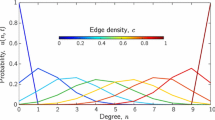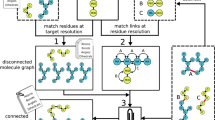Abstract
A conventional by hand construction and parameterization of a polymer model for the purpose of molecular simulations can quickly become very work-intensive and time-consuming. Using the example of polyglycerol, I present a polymer decompostion strategy yielding a set of five monomeric residues that are convenient for an instantaneous assembly and subsequent force field simulation of a polyglycerol polymer model. Force field parameters have been developed in accordance with the classical Amber force field. Partial charges of each unit were fitted to the electrostatic potential using quantum-chemical methods and slightly modified in order to guarantee a neutral total polymer charge. In contrast to similarly constructed models of amino acid and nucleotide sequences, the glycerol building blocks may yield an arbitrary degree of bifurcations depending on the underlying probabilistic model. The iterative development of the overall structure as well as the relation of linear to branching units is controlled by a simple Markov model which is presented with few algorithmic details. The resulting polymer is highly suitable for classical explicit water molecular dynamics simulations on the atomistic level after a structural relaxation step. Moreover, the decomposition strategy presented here can easily be adopted to many other (co)polymers.






Similar content being viewed by others
References
Binder K, Paul W (1997) Monte Carlo simulations of polymer dynamics: recent advances. J Polym Sci B Polym Phys 35:1–31
Brass A, Pendelton BJ, Chen Y, Robson B (1993) Hybrid Monte Carlo simulations theory and initial comparison with molecular dynamics. Biopolymers 33:1307–1315
Cornell WD, Cieplak P, Bayly CI, Kollman PA (1993) Application of RESP charges to calculate conformational energies, hydrogen bond energies, and free energies of solvation. J Am Chem Soc 115:9620–9631
Dernedde J, Rausch A, Weinhart M, Enders S, Tauber R, Licha K, Schirner M, Zügel U, von Bonin A, Haag R (2010) Dendritic polyglycerol sulfates as multivalent inhibitors of inflammation. PNAS 107:19679–19684
Duane S, Kennedy AD, Pendleton BJ, Roweth D (1987) HYBRID MONTE CARLO. Phys Lett B 195:216–222
Fletcher R, Reeves CM (1964) Function minimization by conjugate gradients. Comput J 7:149–154
Frisch MJ, Trucks GW, Schlegel HB, Scuseria GE, Robb MA, Cheeseman JR, Scalmani G, Barone V, Mennucci B, Petersson GA, Nakatsuji H, Caricato M, Li X, Hratchian HP, Izmaylov AF, Bloino J, Zheng G, Sonnenberg JL, Hada M, Ehara M, Toyota K, Fukuda R, Hasegawa J, Ishida M, Nakajima T, Honda Y, Kitao O, Nakai H, Vreven T, Montgomery JAaJEP Jr, Ogliaro F, Bearpark M, Heyd JJ, Brothers E, Kudin KN, Staroverov VN, Kobayashi R, Normand J, Raghavachari K, Rendell A, Burant JC, Iyengar SS, Tomasi J, Cossi M, Rega N, Millam JM, Klene M, Knox JE, Cross JB, Bakken V, Adamo C, Jaramillo J, Gomperts R, Stratmann RE, Yazyev O, Austin AJ, Cammi R, Pomelli C, Ochterski JW, Martin RL, Morokuma K, Zakrzewski VG, Voth GA, Salvador P, Dannenberg JJ, Dapprich S, Daniels AD, Farkas Ö, Foresman JB, Ortiz JV, Cioslowski J, Fox DJ (2009) Gaussian 09 revision A.02. Gaussian Inc., Wallingford
Gasteiger J, Marsili M (1978) A new model for calculating atomic charges in molecules. Tetrahedron Lett 34:3181–3184
Gelman A, Rubin D (1992) Inference from iterative simulation using multiple sequences. Stat Sci 7:457–511
Haag R, Stumbé JF, Stunder A, Frey H, Hebel A (2000) An approach to core-shell-type architectures in hyperbranched polyglycerols by selective chemical differentiation. Macromolecules 33:8158–8166
Halgren TA (1996) Merck molecular force field: I–V. J Comput Chem 17(5–6):490–641
Heinz H, Suter UW (2004) Atomic charges for classical simulations of polar systems. J Phys Chem B 108:18341–18352
Hess B, Kutzner C, van der Spoel D, Lindahl E (2008) GROMACS 4: algorithms for highly efficient, load-balanced, and scalable molecular simulation. J Chem Theory Comput 4:435–447
Hestenes MR, Stiefel E (1952) Methods of conjugate gradients for solving linear systems. J Res Nat Bur Stand 49:409–436
Hornak V, Abel R, Okur A, Strockbine B, Roitberg A, Simmerling C (2006) Comparison of multiple amber force fields and development of improved protein backbone parameters. Proteins Struct Funct Bioinform 65:712–725
Jakalian A, Bush BL, Jack DB, Bayly CI (2000) Fast, efficient generation of high-quality atomic charges. AM1-BCC model: I. Method J Comput Chem 21:132–146
Jakalian A, Jack DB, Bayly CI (2002) Fast, efficient generation of high-quality atomic charges. AM1-BCC model: II. Parameterization and validation. J Comput Chem 23:1623–1641
Johnston K, Harmandaris V (2013) Hierarchical simulations of hybrid polymer-solid materials. Soft Matter 9:6696–6710
Kotelyanskii M, Wagner NJ, Paulaitis ME (1996) Building large amorphous polymer structures: atomistic simulation of glassy polystyrene. Macromolecules 29:8497–8506
van der Spoel D, Lindahl E, Hess B, Groenhof G, Mark AE, Berendsen HJC (2005) GROMACS: fast, flexible, and free. J Comput Chem 26:1701–1718
Wang J, Wang W, Kollman PA, Case DA (2006) Automatic atom type and bond type perception in molecular mechanical calculations. J Mol Graph Model 25:247–260
Weber M, Becker R, Durmaz V, Köppen R (2008) Classical hybrid Monte-Carlo simulation of the interconversion of hexabromocyclododecane stereoisomers. Mol Simul 34:727–736
Acknowledgments
The BAM Federal Institute for Material Research and Testing as well as the Collaborative Research Centre SFB 765 are kindly acknowledged for their cooperation and financial support. Also, I would like to thank Marcus Weber and Frank Cordes for their scientific support.
Author information
Authors and Affiliations
Corresponding author
Rights and permissions
About this article
Cite this article
Durmaz, V. Markov model-based polymer assembly from force field-parameterized building blocks. J Comput Aided Mol Des 29, 225–232 (2015). https://doi.org/10.1007/s10822-014-9817-0
Received:
Accepted:
Published:
Issue Date:
DOI: https://doi.org/10.1007/s10822-014-9817-0




